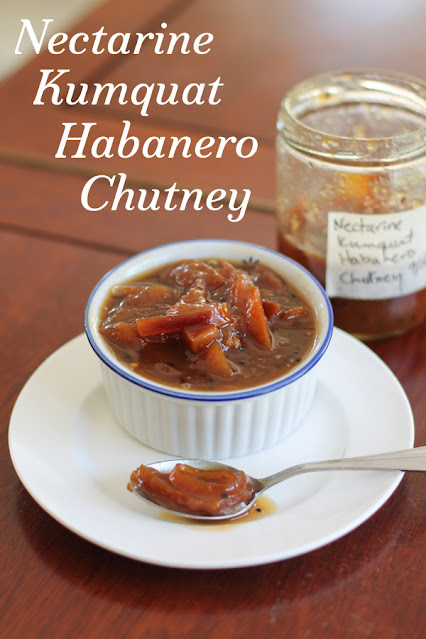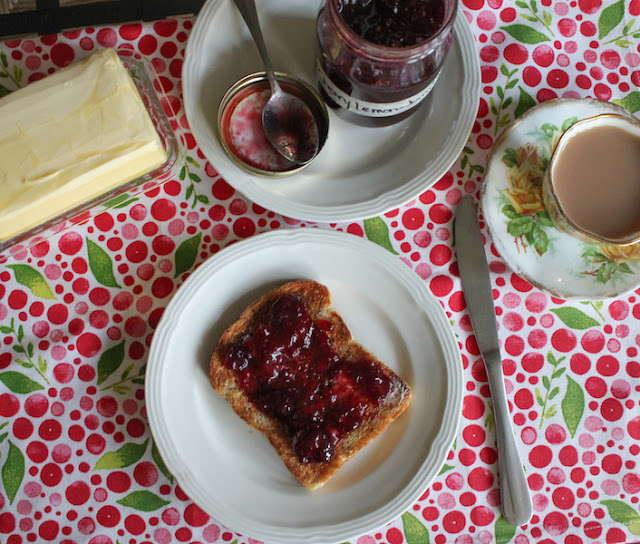This week my Sunday Supper group is sharing recipes that save the summer harvest. I love adding peppers, especially habaneros, to sweet condiments. There’s something special about that hit of heat and sweet that goes so perfectly with pork or chicken. I just can’t resist. One day soon I’ll share the recipe for my confit pork belly, shown here, because it’s my favorite thing to eat with nectarine kumquat habanero chutney. But meanwhile, serve it along side grilled chicken breasts or pan-fried pork chops.
Ingredients
12 1/3 oz or 350g kumquats
3 cups or 710ml apple cider vinegar
3 lbs 12 oz or 1700g nectarines
2 tablespoon canola or other light oil
1 teaspoon brown mustard seeds
12 fenugreek seeds
1 teaspoon cumin seeds
1/2 teaspoon fennel seeds
1/2 teaspoon kalonji
4 in or 9cm piece of cinnamon stick
1 cup or 240ml fresh orange juice
2 large, thick thumb-sized pieces fresh ginger
6 cups or 1200g sugar
3-4 habanero peppers – about 38g
Method
Wash your kumquats and remove any stems. Finely slice them, removing any large green seeds.
Pile them in a bowl and cover them with the vinegar. Push them down into a little if necessary. Cover the bowl with cling film and let marinate for at least one hour or overnight in the refrigerator.
When you are ready to proceed, chop your ginger finely. Mince your fresh habaneros. You can discard the seeds but know that even doing that, this is going to be pretty spicy. Be very careful with the habaneros. I recommend you use gloves. Do not, I repeat, do not touch anything – face, eyes, nose, etc. – before washing your hands very thoroughly with full strength soap, or better yet, an abrasive scouring powder, just in case.
Measure out your spices, putting the mustard seeds in one bowl and the rest of the spices in another.
Seed and thinly slice your nectarines. No need to peel them.

In a large pot, heat the oil and add the mustard seeds. When they start to pop, add in the other spices and give the whole thing a quick stir.
Now add in the chopped ginger and stir again. Pour in the orange juice.
Now add in the kumquats and the vinegar they marinated in. Bring to a low boil and cook for about 10 minutes.
Add in the nectarines, habaneros, the stick of cinnamon and sugar.
Bring the mixture to a boil and then turn the fire down. Be careful at the beginning because the sugar really makes it bubble up. You do not want this to boil over!
Cook until the chutney thickens to your desired consistency. Remember that once it cools, it will thicken even more so stop before you can stand a spoon in it or it will be too thick cold. I cooked mine for almost one hour over a low heat. If you are a thermometer using type, I find that jam or chutney will set when cooled if heated to just under 220°F or 105°C.
Turn off the fire and remove the cinnamon stick.
Transfer the boiling chutney to sterilized jars, popping in clean teaspoons to make sure the jars don’t break. Screw the sterilized lids on tightly. I use the inversion method to seal my jars but experts like Rebecca Lindamood, author of Not Your Mama’s Canning Book does not recommend this. She advocates processing the jars in a boiling water bath or pressure canner.
Enjoy! If you like kumquats, you might also like my spicy tangy sticky kumquat chutney.
Check out all the fabulous recipes our Sunday Supper tastemakers are sharing this week to save the summer harvest. Many thanks to today's host Caroline of Caroline's Cooking and our event manager Renee of Renee's Kitchen Adventures.
Condiments
- Blackberry Lemon Thyme Syrup by Sunday Supper Movement
- Brinjal pickle (Indian eggplant relish/aubergine chutney) by Caroline’s Cooking
- Freezer Mixed Berry Puree by Cindy’s Recipes and Writings
- Ginger Fig Jam by Palatable Pastime
- Herbed Salsa by What Smells So Good?
- Homemade Giardiniera by Curious Cuisiniere
- Homemade Sriracha by Monica’s Table
- Hot Pepper Oil by Feeding Big and more
- Mediterranean Chutney by Wholistic Woman
- Nanny’s 7-Day Sweet Pickles by Grumpy’s Honeybunch
- Nectarine Kumquat Habanero Chutney by Food Lust People Love
- No Pectin Mixed Berry Jam by My Imperfect Kitchen
- Peach Butter by Redhead Baker
- Pear Ginger Jam by Hezzi-D’s Books and Cooks
- Simple Basil Butter by Momma’s Meals
- Spicy Mango Jam by Family Foodie
- Stove Top Roasted Garlic by Cricket’s Confections
- Tomato and Chili Pepper Jam by Delaware Girl Eats
Main dishes
- Grilled Peach and Burrata Pizza by An Appealing Plan
- Oven Roasted Tomato Basil Marinara Sauce by Renee’s Kitchen Adventures
- Tomato-Zucchini Pesto Flatbread with Chevre and Balsamic Drizzle by The Weekend Gourmet
Sides
- Garden Rice by Basic N Delicious
- Pickled Asian Vegetables by A Mind Full Mom
Snacks
- Homemade Fruit Leather by A Kitchen Hoor’s Adventures
- Slow Cooker Cinnamon Apple Sauce by Books n’ Cooks
Dessert
- Chocolate Zucchini Banana Muffins by The Bitter Side of Sweet
- Drunken Peaches by Nosh My Way
- Freeze and Bake Blueberry Pie by That Skinny Chick Can Bake
- How to Freeze Peaches and Make Peach Sauce by The Freshman Cook
- How to Make Chocolate Zucchini Bread by Asian In America
- Mom’s Zucchini Bread by Cosmopolitan Cornbread
- Peach Yogurt Popsicles by Food Done Light
- Summer Fruit Crisp by Pies and Plots
- Summer Fruit Popsicles by Powered By BLING
Beverage
- Berry Shrubs + A Cocktail by Culinary Adventures with Camilla
Pin this Nectarine Kumquat Habanero Chutney!
.























